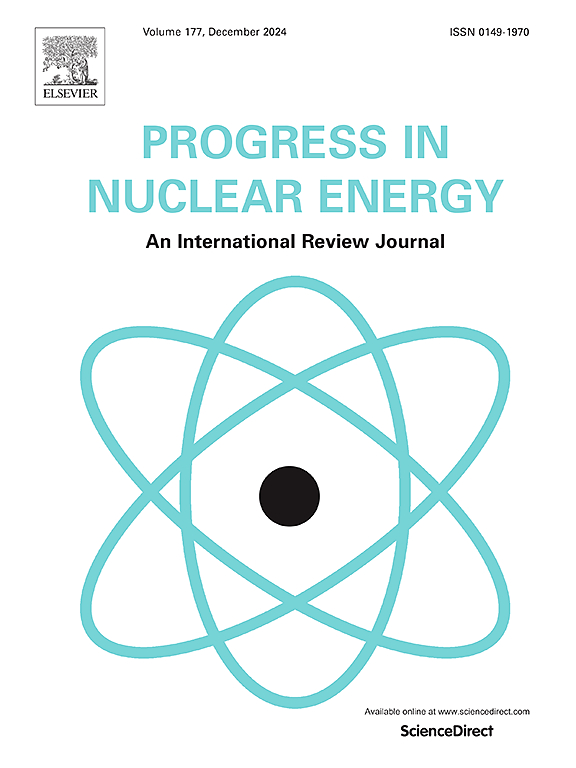Non-destructive evaluation and machine learning methods for inspection of spent nuclear fuel canisters: A state-of-the-art review
IF 3.3
3区 工程技术
Q1 NUCLEAR SCIENCE & TECHNOLOGY
引用次数: 0
Abstract
Nuclear energy is among the cleanest and most efficient energy sources currently available. The operation of nuclear power plants (NPPs) produces large amounts of high-level radioactive waste known as spent nuclear fuel (SNF). Currently, large amounts of SNF is stored in dry cask storage systems (DCSSs) for extended interim storage until a permanent disposal solution becomes available. During the extended interim storage, the DCSS, particularly the SNF canisters, may degrade and abnormal conditions may occur. Therefore, non-destructive evaluation (NDE) and machine learning (ML) approaches are necessary for inspection of SNF canisters. This paper presents a state-of-the-art review of literature by summarizing recent progress made on the applications of NDE and ML for inspection of SNF canisters. Sixteen NDE methods are examined and compared: visual inspection, ultrasonic guided waves (UGWs), laser-based approaches, acoustic emission (AE), eddy current testing (ECT), non-invasive acoustic sensing, dynamic modal testing, cosmic ray muons tomography, neutron imaging, gamma rays detection, fiber optical sensors, through-wall communications, X-ray computed tomography (CT), vibrothermography, monoenergetic photon sources, and surface acoustic wave (SAW) sensors. The technology readiness level (TRL) for each method is assessed and compared. Recent publications on ML-enhanced visual inspection, AE, non-invasive acoustic sensing, dynamic modal testing, and neutron imaging for SNF canisters are summarized and future research needs are identified. This review article provides a convenient reference on the state-of-the-art applications of NDE and ML methods for inspection of SNF canisters.
无损评估和机器学习方法用于检查乏燃料罐:最新的审查
核能是目前最清洁、最有效的能源之一。核电站(NPPs)的运行会产生大量的高放射性废物,即乏核燃料(SNF)。目前,大量SNF储存在干桶储存系统(DCSSs)中,以延长临时储存时间,直到有永久处置解决方案可用。在延长的临时储存期间,dcs,特别是SNF罐可能会退化,并可能出现异常情况。因此,非破坏性评估(NDE)和机器学习(ML)方法对于SNF罐的检测是必要的。本文通过总结NDE和ML用于SNF罐检查的应用方面的最新进展,介绍了最新的文献综述。十六种无损检测方法进行了检查和比较:目视检查,超声导波(UGWs),基于激光的方法,声发射(AE),涡流测试(ECT),无创声传感,动态模态测试,宇宙射线介子断层扫描,中子成像,伽马射线检测,光纤传感器,穿墙通信,x射线计算机断层扫描(CT),振动热成像,单能光子源和表面声波(SAW)传感器。对每种方法的技术准备水平(TRL)进行了评估和比较。总结了最近发表的关于ml增强视觉检测、声发射、无创声传感、动态模态测试和SNF罐中子成像的文章,并确定了未来的研究需求。本文综述了无损检测(NDE)和机器学习(ML)方法在SNF罐检测中的最新应用。
本文章由计算机程序翻译,如有差异,请以英文原文为准。
求助全文
约1分钟内获得全文
求助全文
来源期刊

Progress in Nuclear Energy
工程技术-核科学技术
CiteScore
5.30
自引率
14.80%
发文量
331
审稿时长
3.5 months
期刊介绍:
Progress in Nuclear Energy is an international review journal covering all aspects of nuclear science and engineering. In keeping with the maturity of nuclear power, articles on safety, siting and environmental problems are encouraged, as are those associated with economics and fuel management. However, basic physics and engineering will remain an important aspect of the editorial policy. Articles published are either of a review nature or present new material in more depth. They are aimed at researchers and technically-oriented managers working in the nuclear energy field.
Please note the following:
1) PNE seeks high quality research papers which are medium to long in length. Short research papers should be submitted to the journal Annals in Nuclear Energy.
2) PNE reserves the right to reject papers which are based solely on routine application of computer codes used to produce reactor designs or explain existing reactor phenomena. Such papers, although worthy, are best left as laboratory reports whereas Progress in Nuclear Energy seeks papers of originality, which are archival in nature, in the fields of mathematical and experimental nuclear technology, including fission, fusion (blanket physics, radiation damage), safety, materials aspects, economics, etc.
3) Review papers, which may occasionally be invited, are particularly sought by the journal in these fields.
 求助内容:
求助内容: 应助结果提醒方式:
应助结果提醒方式:


